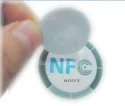2022-03-17
Radiofrequency identification (RFID) describes a system that wirelessly transmits the identity of an object, in the form of a unique sequence of numbers or letters, using radio waves. Although several types of RFID systems exist, this fact sheet describes the technology used in passive, low-frequency RFID tag systems. This is the technology first used in USDA-approved RFID ear tags for cattle. There is no requirement for cattle producers to electronically read RFID ear tags.

However, many producers will find benefit in automating data entry and retrieval by utilizing an RFID system in their management. The four basic components of an RFID system as used in animal identification are: (Figure 1)
- Transponder — The transponder is the electronic data source that stays with the animal you want to identify. The transponder contains a microchip, where the identification number is stored. The transponder is embedded in the ear tag.
- Transceiver — The transceiver (or reader) is used to retrieve the information stored in the transponder. This device is essentially a radio transmitter and an antenna. The transceiver could be part of a hand-held unit that is taken to the location of the animals with the RFID tags or a stationary unit that the animals pass by.
- Data accumulator — This is a device where information received by the transceiver is accumulated or stored. This could be a computer, personal digital assistant (PDA), scale head, or a variety of other electronic devices.
- Processing software — This software transforms the accumulated data into recognizable and useful information. In the case of animal identification, the useful information would be a 15-digit number that is unique to that animal. In a separate process, this information could then be imported into a variety of data management programs.
Transponder
Transponders used most commonly in RFID animal identification systems are called inductively coupled transponders. What this means is that energy to run these types of transponders is supplied by electrical currents produced by electromagnetic fields created by components embedded in the transponder. There are three parts to a typical inductively coupled RFID.
transponder (Figure 2):
- Silicon microprocessor or microchip —These microchips are the data source component of the RFID. The microchip contains a unique 15-digit Animal Identification Number. Passive tags are not able to store additional information.
- Metal coil — The coil is made of copper wire that is wound onto a bobbin. This coil acts as the tag's antenna. The tag transmits signals to the reader, with the reading distance determined by the size of the coil antenna (generally the read distance is 18 inches or less). The metal coil also creates the magnetic field that provides the electrical current to power the transponder.
- Encapsulating material — In RFID systems used for cattle identification, the transponder is most often embedded in a hard polymer shaped in the form of a button ear tag. Inductive RFID tags are passive information storage sites. Retrieving the data stored in them requires an outside energy source. Inductive RFID tags are powered by a magnetic field generated by the antenna in the transceiver or reader. When the tag comes in proximity to the reader, the tag's antenna (metal coil) picks up the magnetic energy and uses this energy to communicate with the reader. Once energized, the tag communicates the animal identification number stored in its microchip back to the reader, which then directs the unique 15-digit Animal Identification Number to the data accumulator. These passive RFID ear tags do not require batteries to be functional. Therefore, they can remain usable for years. The read range of low-frequency passive tags depends on the power of the reader and interference from other radio frequency signals. RFID signals can pass through non-metallic objects such as tissue, mud, wood, etc. Electric motors and fluorescent lights can create interfering radio signals, and metal objects (metal barn siding, gates, stanchions, etc.) reflect radio signals. Interfering radio signals may reduce the overall read range of RFID tags. Under most practical conditions, low-frequency tags are read from a distance of 18 inches or less. Though a short read distance prevents cattle identification from being read across a pasture, it also prevents unintentional reads from tags in a group of animals near one another.

Transceiver
The transceiver or reader contains the scanning antenna that emits radio frequency signals in a relatively short range. The radio frequency signal does two things: provides a means of communicating with the transponder, and it provides the passive RFID ear tags with the energy to communicate back to the transceiver.
When an RFID transponder or ear tag passes through the field of the scanning antenna, it detects the activation signal. This "wakes up" the RFID chip, and it transmits the information on its microchip to be detected by the scanning antenna. The transceiver can take many forms. Transceivers that are used for cattle identification can be affixed to alleyways in sale barns or working facilities or to door frames on semi-trailers, or they can be incorporated into portable hand-held devices such as wands or PDAs. Data Accumulator and Processing Software The data accumulator is the electronic device that stores the data gathered by the transceiver. Data accumulators can be packaged together with the transceiver in a hand-held device, or they can be located in a remote location and connected to the transceiver by a wire or wirelessly. Examples of data accumulators used in the cattle industry include PDAs, scale heads, and computers.
After the data has been accumulated and stored, the processing software takes the gathered electronic signals and converts them into a recognizable and useful format. In the case of an animal identification system, the data is converted to a 15-digit number that can be read visually and stored, and utilized in a data management program.
Author — Dan Grooms, Michigan State University, in collaboration with the Michigan RFID Education Task Force
Categories
Title with button
this is a new beginning
We provide all your needed for starting your own online business, and even easier. Establish an online store, Oceans of Products Supply, Integrate Logistics Solution & Comprehensive After-sale Services.




